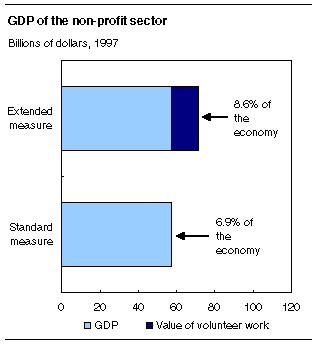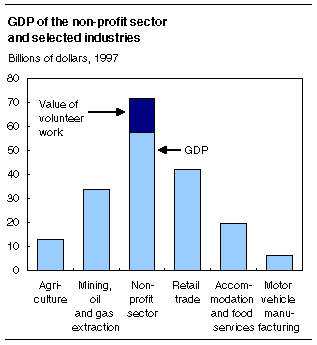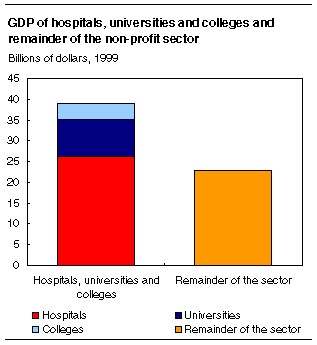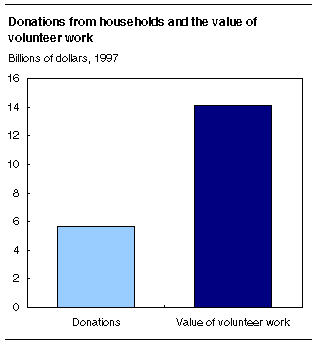
















 |
|
 |                |
Information identified as archived is provided for reference, research or recordkeeping purposes. It is not subject to the Government of Canada Web Standards and has not been altered or updated since it was archived. Please "contact us" to request a format other than those available.

|

Monday, September 20, 2004 Non-profit institutions and volunteering: Economic contribution1997 to 1999The economic contribution of the non-profit sector is larger than many major industries in Canada, and amounted to 6.8% of gross domestic product (GDP) in 1999, according to the first-ever official estimates. The economic contribution of the non-profit sector increases to 8.6% when volunteer work is taken into account. 
The non-profit sector includes hospitals, universities and colleges, along with a diverse range of other, typically smaller, organizations. Hospitals, universities and colleges account for the lion's share of non-profit economic activity.
In 1999, the non-profit sector's GDP (the value of the productive activity generated as non-profit organizations undertake their missions) was estimated at $61.8 billion, or 6.8% of the total economy. Because the non-profit sector relies heavily on volunteers to undertake its activities, standard measures of GDP are extended to include a replacement cost value of volunteer work. This represents the cost to replace volunteer effort if the same services were purchased on the labour market. Extended measures of the sector's contribution, which take into account the value of volunteer work, were estimated for 1997. In that year, standard GDP was $57.5 billion and accounted for 6.9% of the economy. When the value of volunteer work is added to this figure, the economic contribution of the non-profit sector increases to 8.6%. Volunteer labour services contribute about $14 billion, accounting for nearly 20% of the total extended value of the non-profit sector's GDP. Canada's non-profit sector is larger than many major industriesThe non-profit sector is not an industry, and non-profit organizations span a range of industry groups. Its GDP can nonetheless be compared with that of major Canadian industries as a point of reference to provide an indication of the scale of its economic activity. Largely due to the presence of hospitals, universities and colleges, the sector's total economic contribution is larger than many major industries in Canada. The non-profit sector's extended GDP is more than eleven times that of the motor vehicle manufacturing industry, over four times larger than agriculture, and over twice the value of the mining, oil and gas extraction industry. It is more than one and a half times Canada's retail trade industry. The GDP of the non-profit sector exceeds that of these major industries irrespective of whether volunteer work is included in its value. 
Sector heavyweights: hospitals, universities and collegesHospitals (including residential care facilities), universities and colleges accounted for the lion's share of non-profit economic activity in 1999, as their combined GDP reached $39.0 billion, or 63% of the total. Of this $39.0 billion, hospitals generated twice as much value added, $26.1 billion, as universities and colleges, at $12.8 billion. These primarily large organizations fell mostly into the fields of health and education. As a result, these fields of activity dominate the Canadian non-profit sector's GDP. 
The activity of other organizations spans a broad range of fieldsTo get a clearer view of the diversity of other organizations in the non-profit sector, the contribution of hospitals, universities and colleges was excluded from GDP. The rest of the sector is generally made up of smaller organizations, functioning in a broad range of fields. In 1999, their GDP was $22.8 billion, or 37% of the total non-profit sector. Of the $22.8 billion, over 20% was generated in the field of social services, followed by culture and recreation (about 16%), development and housing (15%), religion (11%), business and professional associations and unions (nearly 10%) and health (9%). These six fields of activity accounted for the bulk (over 80%) of the GDP generated by this group. Labour compensation the largest expense for non-profit sectorWages and salaries comprise the largest expense for the non-profit sector, particularly for hospitals, universities and colleges. In 1999, current spending by non-profit organizations totalled $95.1 billion, 98% of which represented operating expenses incurred to produce goods and services. The remainder consisted of transfers to other sectors of the economy. Two expenditure categories accounted for nearly 95% of total operating expenses. Compensation of employees was the largest and accounted for 57% of the total. Intermediate purchases, that is, current spending on goods and services used in production represented 37%. The remaining 6% of operating expenses were depreciation expense and taxes less subsidies on factors of production. Volunteer activity represents one-quarter of total labour servicesValuations of volunteer activity are approximate and reflect imputations using volunteer hours reported on the Canada Survey of Giving, Volunteering and Participating multiplied by comparable wage rates in the market economy. When paid labour compensation and the replacement cost value of volunteer work are combined, the result is an extended value of total labour services used by the non-profit sector. In 1997, the sector paid $48.9 billion in labour compensation and benefited from volunteer effort worth about $14 billion. The value of volunteer work amounted to roughly one-quarter of the total value of labour services provided to the non-profit sector. The overall value of labour resources employed by the non-profit sector is equivalent to 13.5% of the wage bill for the Canadian economy. Volunteer time worth more than double the value of donations from individualsVolunteering is a resource that exceeds, by far, the value of donations from households to the non-profit sector. In 1997, households donated $5.7 billion to the non-profit sector. The value of volunteer contributions of time was more than double this amount (about $14 billion). Combining the value of volunteer work with donations from households would triple the importance of households' contribution to overall revenue for the non-profit sector—from 6.5% to nearly 20% of the total. 
Culture and recreation organizations use most volunteer effortFour areas of activity accounted for most of the value of volunteer work. The culture and recreation field drew on $3.6 billion worth of volunteer effort in 1997. It was followed by social services ($3.0 billion), religion ($2.5 billion) and education and research ($1.8 billion). These four groups collectively accounted for 77% of the value of volunteer work and a much smaller proportion of paid labour compensation (about 38%). The health field, which is dominated by hospitals, relies far more heavily on paid labour than on volunteer effort. In 1997, the wage bill for the health field, an estimated $23.9 billion, dwarfed all other areas. Education and research also employed a significant amount of paid labour resources, amounting to over $11 billion. The health and education fields dominate paid labour services in the non-profit sector, accounting for nearly three-quarters of the overall value. In contrast, they accounted for only 21.5% of the value of volunteer work. The value of volunteer work fell between 1997 and 2000The value of volunteer work fell marginally between 1997 and 2000, from an estimated $14.1 billion to about $14.0 billion. The decline in the value was because of a drop in hours volunteered over this period. In 2000, the value of volunteer work amounted to 1.4% of Canada's GDP—down from 1.7% in 1997. Patterns in volunteering can be affected by a shifting of resources from the non-market to the market sector that occurs with economic cycles. Between 1997 and 2000, Canada's economy advanced an average of 4.9% per year and the employment rate rose from 59.0% to 61.4%. The full report for the Satellite Account of Non-profit Institutions and Volunteering, 1997 to 1999 (13-015-XIE, free) and (13-015-XWE, free) is now available online. From the Our products and services page, under Browse our Internet publications, choose Free, then National accounts. For more information, or to enquire about the concepts, methods or data quality of this release, contact the information officer (613-951-3640, iead-info-dcrd@statcan.gc.ca) Income and Expenditure Accounts Division. |
|
|
|